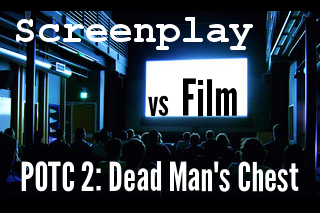This week’s Screenplay vs Film selection is the second installment of the Pirates of Caribbean franchise–Dead Man’s Chest. In this sequel, Captain Jack Sparrow (Johnny Depp) races to recover the heart of Davy Jones to avoid enslaving his soul to Jones’ service, as Will Turner, Elizabeth Swann & Lord Beckett seek the heart for their own agenda as well. Dead Man’s Chest was filmed back to back with the third Pirates of the Caribbean movie, At World’s End, and was the first movie to gross a billion dollars worldwide. No small feat.
The screenplay I’m comparing the produced movie to is straight from the screenwriters’ website. Well, one of the screenwriters, as Terry Rossio usually writes with writing partner Ted Elliot. Terry very kindly put up a draft of Dead Man’s Chest on his website Wordplay. It’s the draft they used going into production, although, according to him, there are a few differences, mostly “changes due to improvisations, last second rewrites, or editing choices, for content as well as running time.”
There aren’t many changes though. I found only about twelve or so, and a good portion of them didn’t yield any screenwriting tips. You also might think that the tips I learned by comparing the screenplay and movie are a little nit-picky…but these are the little things that elevate your screenplay above the thousands of others vying for attention in Hollywood.
I think that Dead Man’s Chest is a great movie to study for aspiring screenwriters because it is a standout example of writing characters who never lose sight of their goals. Despite being 2 hours long and then some, the movie never loses its momentum or comes across as aimless because each scene propels Jack, Will & Elizabeth closer to achieving their heart’s desire. A lot of amateur screenplays forsake character goals in order to add an action-adventure sequence or comedy gag but in Dead Man’s Chest the plot never gets thrown overboard (couldn’t resist!) in the name of entertainment.
The other thing that I love about this movie is its inventiveness. I’ve never seen characters imprisoned in balloons of bones, men who were half-barnacle & half-human, or a three way duel…and yes, while that sequence did go a little too long, the screenplay is a fast-paced read full of stunningly written swashbuckling adventure.
So here are the screenwriting tips I learned by comparing the Dead Man’s Chest screenplay to its movie. Like I said, some of the differences are tiny, but they’re worthwhile to examine.
Screenwriting Tip #1: Starting your screenplay
The movie starts with rippling waves followed by showing Elizabeth crying on her wedding day as the rain pours, soaking everything around her. On what should be the happiest day of her life, her fiance, Will Turner, is arrested–then so is she! I think that’s a fine way to start the movie, especially since screenwriting instructor Hal Ackerman drew my attention to propitious events in his book Write Screenplays that Sell–the Ackerman Way.
Propitious or auspicious occasions…give the story a sense of moment. I don’t consider the propitious occasion a mandatory component, but you’d be surprised how often it is used. Like every other technique, it must derive organically from the circumstances of the story. You’d fire the architect who put a turret on a ranch house.
It’s a perceptive observation, and one of the many reasons I love his screenwriting guide.
The screenplay however started with Gibbs, on deck of the Black Pearl, singing that famous pirate chanty, “Fifteen men on a dead man’s chest…” which also makes for a great beginning.
At first, I was puzzled by the change. I mean this has the title of the movie in it. Plus, it seemed better to start off with Gibbs than with Elizabeth because in my mind, Jack Sparrow’s storyline, of which Gibbs and the Black Pearl are essential elements, was the MAIN story in the movie. Will and Elizabeth’s storyline was secondary.
Thanks to Terry’s website article Nine Pieces of Eight, I was able to get the reason for the change straight from the screenwriter’s mouth. He wanted to start with a song to “match the opening of the first film, with the singing on the ‘Pirates Life for Me’ song. And then we’d have another song for the third film, so they would all match. Gore and the editors said they tried it that way, but it didn’t work; it was too difficult to cut from Jack’s story to the wedding, Jack’s story was so compelling it made it difficult for the audience to buy into the wedding, to care about the wedding. They might be right, but part of me is doubtful, I would have liked to have at least seen it once the original way.”
So there’s your answer. When I originally wrote this post, I agreed with Terry Rossio. I thought it would’ve been been cooler to see Dead Man’s Chest start with the pirate song. But now, I’m leaning toward Verbinski’s point of view. It’s better to sacrifice the symmetry between all three film openings in order to preserve the momentum of the second film’s beginning.
Now, when you’re starting your screenplay, don’t spend too much time mulling over the best way to begin it. Just start the bloody thing. But when you’re in the revising stages, spend time deciding what is the best starting point for your story–and what tradeoffs you might have to make as a result.
Generally, if you’re writing a thriller, you want to start with something thrilling. If you’re writing a comedy, then start with something funny. But you should also think about WHOM you’re starting with. 90% of the time, your best bet is the hero. You should have a really compelling reason to start with a different character.
The other consideration is what day in your hero’s life do you start with? The average day of even the most fascinating character can be pretty boring. Gru in Despicable Me isn’t pulling off a heist every day; the wolf pack in The Hangover isn’t always getting married & drunk in Vegas.
That’s why the best screenplays don’t start on any old day–but on a milestone, a day whose significance usually relates to plot or thematic developments. I think another reason screenplays tend to start on special days is because these milestone events raise the stakes. An unmarried woman has more to lose on her 30th birthday (tick, tick, tick) than on her 24th. A cop about to retire with a cushy pension has more at stake than a cop seven years into his job.
Screenwriting Tip #2: Arrange your scenes to create the most story tension
In the screenplay and movie versions of Pirates of the Caribbean 2, Elizabeth manipulates the crew of a small boat into docking at Tortuga. She arranges oil from a ship’s lantern to spell out the port’s name and sets the oil on fire to create flaming letters on the ship’s deck. The crew believes it’s a sign from a spirit and heads to this infamous pirate port.
In the screenplay however, this scene occurs way before Jack heads to Tortuga. In the screenplay, Elizabeth plays her trick, and then we make a stop at Tia Dalma’s shack, meet the Flying Dutchman for the first time, watch Captain Sparrow and Davy Jones confronting each other, finally agreeing that Jack must provide Jones with 99 more souls in three days time…and there’s no better place to find lost souls than Tortuga.
In the movie, Jack first decides to sail to Tortuga, which is quickly followed by Elizabeth playing her trick, forcing her ship to dock at Tortuga too. This creates a delicious bit of anticipation as we can’t wait for these two characters–Jack and Elizabeth–to confront each other in Tortuga.
If Elizabeth’s trick occurred earlier the way it did in the screenplay, there’s a lot of time, about 15 pages worth, between her sailing and Jack’s. The odds are we’ll only remember Elizabeth said she was sailing towards the same port once we see both of them in Tortuga, which means that we lose that feeling of anticipation.
So if you’re confused as to where to put a certain scene, see if placing it after event G is creates more anticipation than placing after event C. If it does, you have your answer!
Screenwriting Tip #3: Show failure before success
In the screenplay and movie of Dead Man’s Chest, the crew of the Black Pearl is captured by a group of cannibal tribesmen, split into two groups, and placed in spherical cages made from human bones. Creepy–and creative. Anyway, these two groups, still entrapped in their spheres, scrabble up a cliff, each group trying to outrace the other to the top.
This is how they describe it in the screenplay:
EXT. CANNIBAL ISLAND – CHASM – DAY
Will rocks the bone cage, trying to get it to the far wall. The other pirates help. Will calls over to the second cage:
WILL
Swing your cage — get to the wall!
The second cage group gets the idea, starts to imitate the first cage. Both reach the chasm wall, grab onto the vines.
WILL (CONT’D)
Put your feet through. Start to climb!
Each group pulls, climbs up the cliff wall.
WILL (CONT’D)
Come on, men, we’ll need all of us to crew the Black Pearl!
LEECH
(calling back)
Actually, we don’t need everyone. About six would do.
A moment as this sinks in…and Leech realizes he said too much. Each cage scrambles for the top. It has become a race, whichever gets away first will leave the other behind.
In the movie, they did it a little differently. They showed the two groups trying to grasp vines on the opposite cliffside–but failing. Repeatedly.
It’s a funny scene especially because of the music, so adding their failed attempts certainly enhances the movie. But even if it hadn’t be scored to create humor, and had been shown more seriously, it’s still a wise screenwriting choice to show the men failing before they succeed.
This is a good choice not just because it reflects real life. Who gets it right on their first try except for Martha Stewart? Even better, this screenwriting choice creates story tension. Even though at some level, we know the crew has to succeed (otherwise the story would stop there, only 30 minutes into it), we’re in a state of stomach-churning tension until we actually witness their success.
I think that’s why we see a lot of “third time’s a charm” sequences in movies. The first two times keep us in suspense, while the last time, the successful time, gives us relief. So even though you may think you should jump straight to your character succeeding, see if showing him failing a couple of times adds to the tension in your story. If there’s a ticking clock, it certainly will!
Final thoughts
This is getting a little long, even though there are only 3 screenwriting tips here! So I’m going to post the rest of the tips I learned from Pirates of the Caribbean: Dead Man’s Chest tomorrow. On Friday, the usual list of Plot Points from the movie should go up, and there’s lots of screenwriting structure lessons to learn from POTC 2. Next week, I hope to share reasons why Dead Man’s Chest made a billion dollars and how you can employ a similar screenwriting strategy in your own future blockbuster.
Watching a blank screen (with modifications) by Kenneth Lu




















